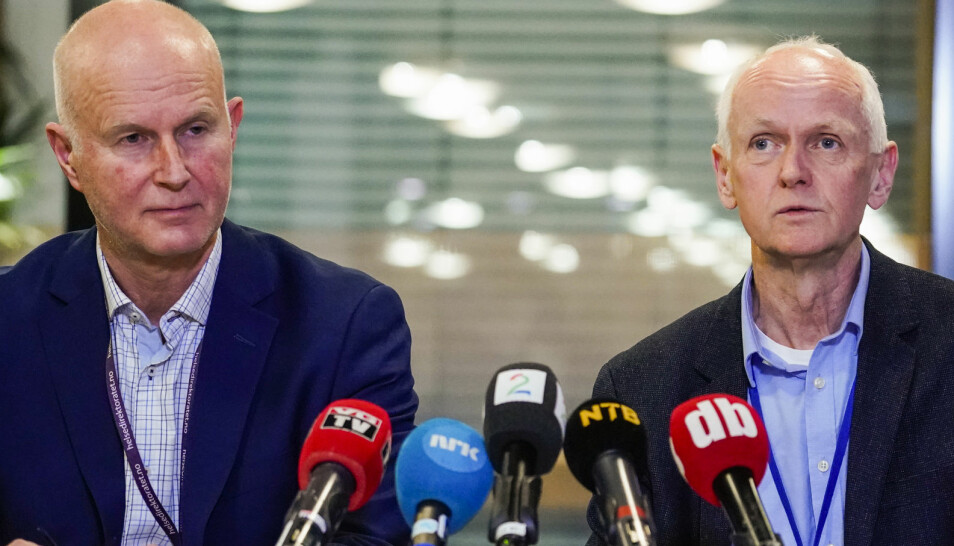
Norwegian government: "The goal is to beat the coronavirus epidemic as much as possible"
The goal is to delay the spread of infection as much as possible, says Espen Rostrup Nakstad from the Norwegian Directorate of Health. Geir Bukholm from the Norwegian Institute of Public Health says the end point will likely be immunity in the Norwegian population.
"Our goal is to knock out the epidemic as much as we can," said Espen Rostrup Nakstad, acting assistant health director at the Norwegian Directorate of Health at a press conference on March 24 on measures to control the coronavirus outbreak in Norway.
"Our ambition is to knock out the virus," said Health Minister Bent Høie.
Prime Minister Erna Solberg used the term “stop the virus”.
For that reason, the Norwegian government is continuing with strict measures for another three weeks, including closed schools, quarantines and travel restrictions. The measures will continue through April 13. At least for now.
Can the virus be knocked out or is it impossible to stop?
"Beating the virus, beating the epidemic, stopping the virus" are all policies in sharp contrast to what Geir Bukholm of the Norwegian Institute of Public Health said on March 23:
"We don’t think it is possible to stop the epidemic," said Bukholm, who is the executive director for the Norwegian Institute of Public Health’s Division of Infection Control and Environmental Health.
“Our latest estimates suggest that 40 to 60 per cent of the Norwegian population can be infected,” Bukholm said.
- Read more about this here: Norwegian health official: "We don’t think it's possible to stop the COVID-19 epidemic"
No contradiction
"There are no conflicts in the two messages, the endpoint is that we have to have immunity in the population," Bukholm said in a comment to forskning.no on Tuesday night.
The measures we have implemented will delay the epidemic right now. We have said this the whole time and that is what has been agreed on, says Bukholm.
Bukholm says Norway needs to reach an infection level that will allow the health care system to get up to speed so it can take care of both Covid-19 patients and all ordinary patients.
Immunity in the population can either be achieved if the population becomes naturally immune to the virus, or by vaccination. A vaccine will take at least a year from now to develop.
About the same message
"It's a little strange that Bukholm was saying this Monday, and the government gave the impression during the press conference Tuesday that the virus can be better controlled," said Anne Spurkland to forskning.no. Spurkland is an immunologist and professor of medicine at the University of Oslo.
But she also believes that the two messages are more or less the same, with one presenting the best-case outcome, and the other the worst-case.
“Bukholm is describing the outcome of the pandemic, and the government is talking about best-case outcomes,” she said.
Buying time
Norway will probably end up somewhere in the middle of these two outcomes, preferably closer to actually getting control of this as soon as possible, Spurkland writes in an email.
The measures will not stop the infection completely until after Easter, but they will buy us time, so it will be possible to ease up a little on the restrictions on our everyday lives, she writes.
“Then the health authorities can instead focus on intensive contact tracing and isolating people who are infected.”
Need more time to see if measures have an effect
Bukholm from the Institute of Public Health says they need more time to see if the restrictions that have been put in place to date are working.
“We have made a model where we can predict how the situation will develop over the next few weeks. We have fed the model up-to-date data, but some of the measures that were implemented on March 12 have not yet shown an effect,” he said.
“We need a few days before we’ll see the effectiveness of the measures,” Bukholm said. “After that, we have to look at whether we’ve been able to control the spread of the infection with these measures, with the possibility of replacing some of them with other actions.”
He can't say how long we will have to live with the epidemic.
Norway is only in phase 2 of 5
According to Line Vold at the Norwegian Institute of Public Health, Norway is currently only in phase 2 of the Covid-19 epidemic, just before the main wave of the epidemic. Vold is the department director for infection control and emergency preparedness.
According to the Institute’s website, the main wave of infection will be during phase 3, where the virus will spread widely throughout communities.
"We must delay the epidemic as much as possible so we have the lowest possible number of cases at its peak," she said at the press conference.
But health officials still don't know when this peak will arrive.
Phase 4 is a full-on epidemic, which will impose a huge burden on the health sector. Phase 5 is when the number of cases declines.
Reducing number of infections critical
Norway’s main focus now is to limit the number of infections, meaning how many people are infected by each infected person.
“The reproduction number R, or the number of infections, is the average number of people who are infected by one infected person,” said Vold.
At the start of the outbreak, the R value was 2.4, meaning each person who had Covid-19 infected 2-3 new people.
If that infection number is now 1.3, that would be an improvement, but Vold said health officials don’t yet have data to know if the government’s measures have had an effect.
The best thing is if we can bring that number down to 0.9, said Vold. We can do this by limiting contact between people, among other measures.
At that point the number of new infected individuals should flatten out.
Must protect at-risk groups
"Each person has to infect as few other people as possible, because that will allow us to buy time," the Directorate of Health’s Nakstad said at the press conference.
“Then we can improve our testing capacity, learn more from the experiences of other countries and focus more on vaccines,” he said. “We need to make sure that the health care system is able to increase its capacity so that it has the ability to treat patients who don’t have the coronavirus.”
We must also protect people who are at risk, he said.
"We may need to institute extra measures for people belonging to risk groups," said Nakstad.
Translated by: Nancy Bazilchuk
———

































